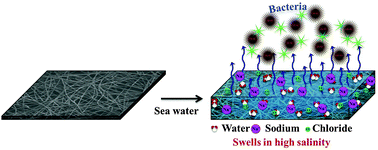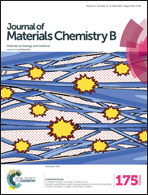Antibacterial, electrospun nanofibers of novel poly(sulfobetaine) and poly(sulfabetaine)s†
Abstract
Polymers capable of forming hydration layers have gained increasing attention due to their ability to form environmentally friendly antifouling surfaces. Zwitterionic polymers are an important class of materials under this category. However, the effectiveness of many zwitterionic polymers for long-term applications is compromised because of their solubility in sea water, poor hydrolytic stability and deteriorating mechanical integrity upon wetting. This study reports on the preparation and characterization of electrospun fibers derived from novel polysulfobetaine and polysulfabetaines (PSBs) composed of polyvinylbenzyl backbones. The morphology of the electrospun nanofibers was elucidated with the help of a scanning electron microscope. Hydration studies were conducted in deionized water and artificial sea water. Antifouling performance of the electrospun nanofibers was evaluated by studying the adhesion and growth of bacteria in natural, and filtered sea water. Terminal restriction fragment length polymorphism (TRFLP) fingerprinting was performed to determine the nature of the bacterial community attached to the electrospun fibers. Some of the PSBs prevented bacterial growth without showing any biocidal nature. Thus the findings of this study are potentially relevant for current trends seeking environmentally friendly antifouling solutions.



 Please wait while we load your content...
Please wait while we load your content...